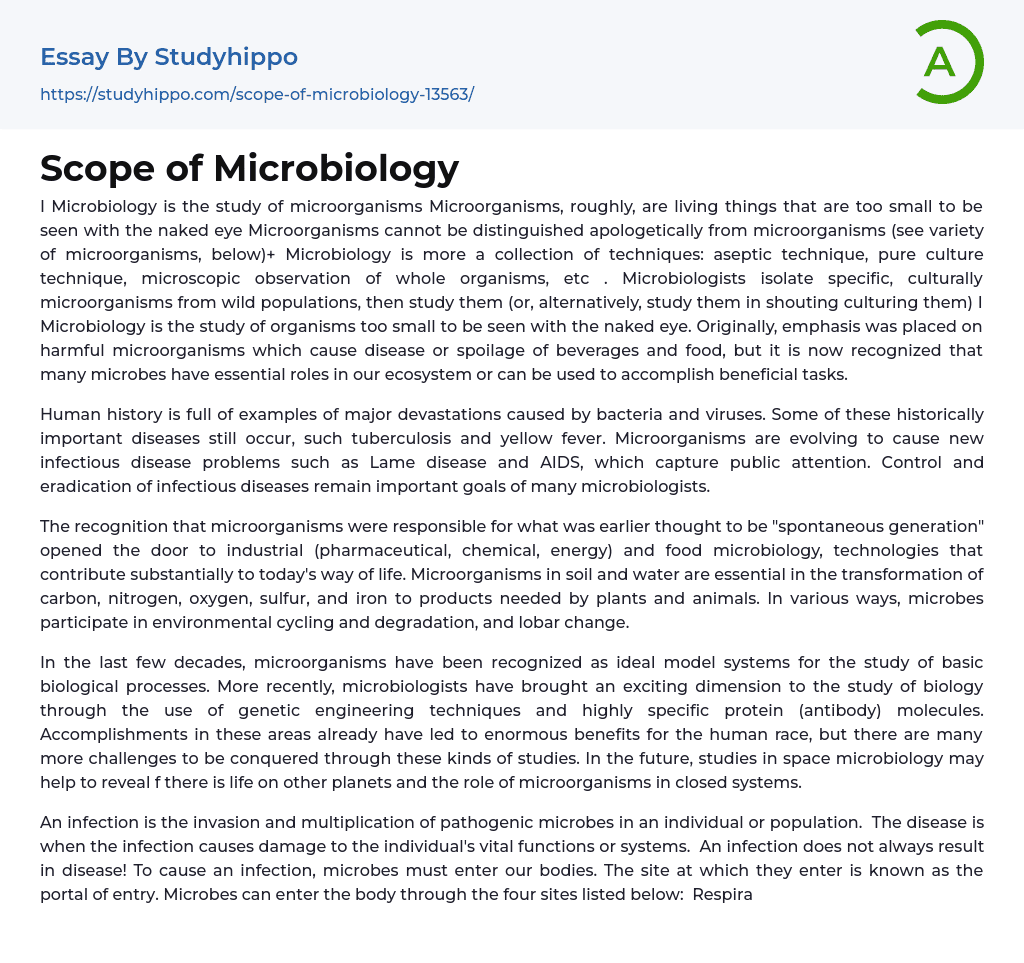Microbiology, which involves the study of microorganisms that cannot be seen with the naked eye, encompasses various techniques such as aseptic technique, pure culture technique, and microscopic observation. Microbiologists isolate specific microorganisms from wild populations to examine them. Initially centered on harmful microorganisms leading to disease or spoilage, microbiology now acknowledges the significant roles of numerous microbes in our ecosystem and their potential for beneficial applications.
Throughout history, there have been many devastating outbreaks caused by bacteria and viruses. Some diseases from the past, like tuberculosis and yellow fever, still exist today. However, microorganisms constantly evolve and create new infectious diseases that worry the public, such as Lame disease and AIDS. Therefore, microbiologists consider it essential to control and eliminate infectious diseases.
Understanding that microorganisms were the cause of what was previously believed
...to be "spontaneous generation" has paved the way for advancements in industrial (pharmaceutical, chemical, energy) and food microbiology. These technologies greatly contribute to our modern way of life. Microorganisms found in soil and water are vital in converting carbon, nitrogen, oxygen, sulfur, and iron into substances required by plants and animals. Microbes also play important roles in environmental cycling, degradation, and lobar change.
Microorganisms have become widely acknowledged as excellent model systems for studying fundamental biological processes over the past few decades. In addition, microbiologists have enhanced the field of biology by employing genetic engineering techniques and specific protein (antibody) molecules. These advancements have already yielded significant advantages for humanity, but there are still numerous challenges that can be addressed through such investigations. Furthermore, investigations in space microbiology hold the potential to unveil whether life exists on other planets and the
significance of microorganisms in enclosed systems.
Infections happen when harmful microbes invade and reproduce in a person or group. Disease occurs when the infection harms the essential functions or systems of the person. However, not all infections lead to disease. The portal of entry is where microbes enter the body. There are four sites through which microbes can enter: the respiratory tract (mouth and nose) - for instance, the influenza virus that causes flu; the gastrointestinal tract (mouth oral cavity) - for example,...
The passage discusses the infection process of specific pathogens, including Brio cholera (causing cholera) and Escherichia coli (causing cystitis), as well as Colostomies tenant (causing tetanus). It states that these bacteria can enter our body through breaks in the skin surface. To cause illness, these microbes must reach their target site, attach to it securely, obtain nutrients from the host, and evade or survive attacks from the immune system. Some bacteria are pathogenic and capable of causing diseases when they invade inappropriate locations.
Like the helpful E. Coli in the intestine, when they enter the bladder, they can cause a painful bladder infection. Soil microbiology focuses on studying organisms in soil, including their functions and the impact they have on soil properties. It is believed that ancient bacteria and microorganisms emerged in Earth's primitive seas between two and four billion years ago. These bacteria had the ability to fix nitrogen, reproduced over time, and as a result, released oxygen into the atmosphere. The release of oxygen ultimately facilitated the development of more advanced microorganisms.
Soil microorganisms play a crucial role in shaping and enriching soil quality. They encompass various groups like
bacteria, stationmasters, fungi, algae, and protozoa, each with unique characteristics and functions within their respective soil habitats. For instance, bacteria facilitate nitrogen fixation, wherein atmospheric nitrogen is converted into nitrogen-containing compounds such as ammonia, which plants can readily absorb for their growth.
Atrophic bacteria, such as the Entertainers species, obtain their energy through oxidation rather than consuming plants or other organisms. These bacteria play a crucial role in nitrogen fixation, although their population is relatively small compared to heterocyclic bacteria. Unlike atrophic bacteria, heterocyclic bacteria derive energy by consuming plants or other agrarianism. However, nitrogen-fixing bacteria are essential because nearly all plants and organisms rely on nitrogen in some capacity and would be unable to obtain it without these bacteria.
- Bacteria essays
- Biotechnology essays
- Breeding essays
- Cell essays
- Cell Membrane essays
- Cystic Fibrosis essays
- Enzyme essays
- Human essays
- Microbiology essays
- Natural Selection essays
- Photosynthesis essays
- Plant essays
- Protein essays
- Stem Cell essays
- Viruses essays
- Apoptosis essays
- Asthma essays
- Black Death essays
- Breast Cancer essays
- Cholesterol essays
- Chronic essays
- Chronic Pain essays
- Death essays
- Diabetes essays
- Down Syndrome essays
- Epidemic essays
- Hypertension essays
- Infection essays
- Infertility essays
- Myocardial Infarction essays
- Pain essays
- Pathogen essays
- Pregnancy essays
- Sexually Transmitted Disease essays
- Symptom essays
- Tuskegee Syphilis Experiment essays
- Water supply essays




